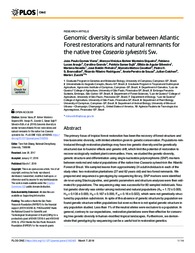Genomic diversity is similar between Atlantic Forest restorations and natural remnants for the native tree Casearia sylvestris Sw.
Genomic diversity is similar between Atlantic Forest restorations and natural remnants for the native tree Casearia sylvestris Sw.
Author(s): VIANA, J. P. G.; SIQUEIRA, M. V. B. M.; ARAUJO, F. L.; GRANDO, C.; SUJII, P. S.; SILVESTRE, E. de A.; NOVELLO, M.; PINHEIRO, J. B.; CAVALLARI, M. M.; BRANCALION, P. H. S.; RODRIGUES, R. R.; SOUZA, A. P. de; CATCHEN, J.; ZUCCHI, M. I.
Summary: The primary focus of tropical forest restoration has been the recovery of forest structure and tree taxonomic diversity, with limited attention given to genetic conservation. Populations reintroduced through restoration plantings may have low genetic diversity and be genetically structured due to founder effects and genetic drift, which limit the potential of restoration to recover ecologically resilient plant communities. Here, we studied the genetic diversity, genetic structure and differentiation using single nucleotide polymorphisms (SNP) markers between restored and natural populations of the native tree Casearia sylvestris in the Atlantic Forest of Brazil. We sampled leaves from approximately 24 adult individuals in each of the study sites: two restoration plantations (27 and 62 years old) and two forest remnants. We prepared and sequenced a genotyping-by-sequencing library, SNP markers were identified de novo using Stacks pipeline, and genetic parameters and structure analyses were then estimated for populations. The sequencing step was successful for 80 sampled individuals. Neutral genetic diversity was similar among restored and natural populations (AR = 1.72 ± 0.005; HO = 0.135 ± 0.005; HE = 0.167 ± 0.005; FIS = 0.16 ± 0.022), which were not genetically structured by population subdivision. In spite of this absence of genetic structure by population we found genetic structure within populations but even so there is not spatial genetic structure in any population studied. Less than 1% of the neutral alleles were exclusive to a population. In general, contrary to our expectations, restoration plantations were then effective for conserving tree genetic diversity in human-modified tropical landscapes. Furthermore, we demonstrate that genotyping-by-sequencing can be a useful tool in restoration genetics.
Publication year: 2018
Types of publication: Journal article
Observation
Some of Embrapa's publications are published as ePub files. To read them, use or download one of the following free software options to your computer or mobile device. Android: Google Play Books; IOS: iBooks; Windows and Linux: Calibre.
Access other publications
Access the Agricultural Research Database (BDPA) to consult Embrapa's full library collection and records.
Visit Embrapa Bookstore to purchase books and other publications sold by Embrapa.

